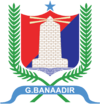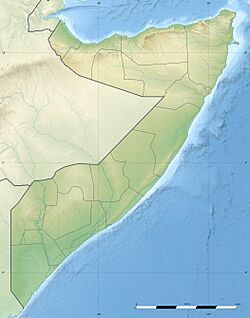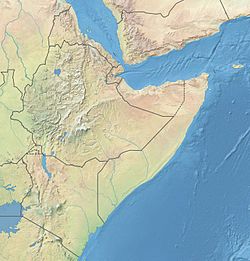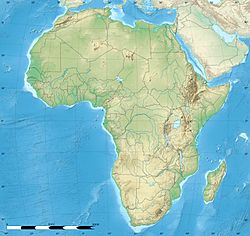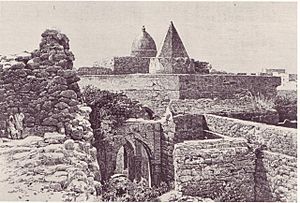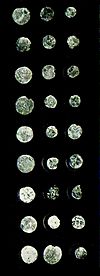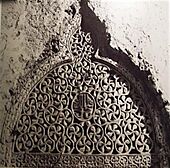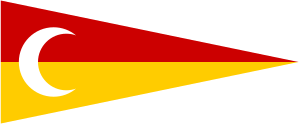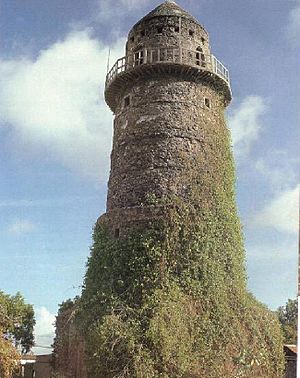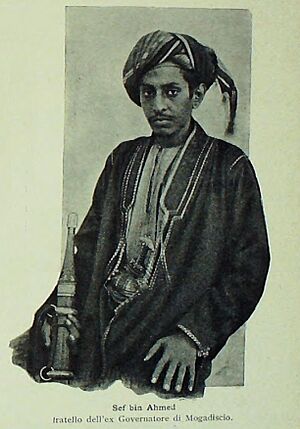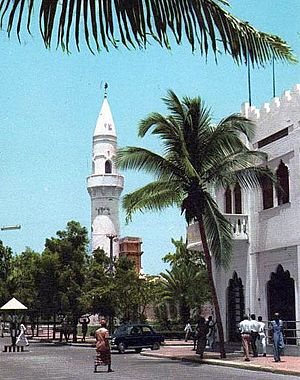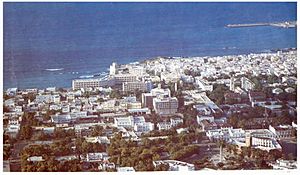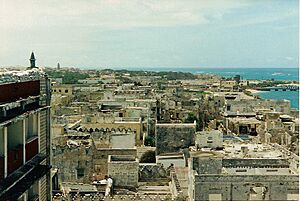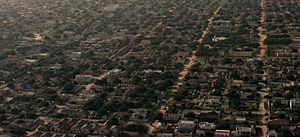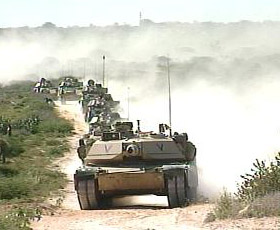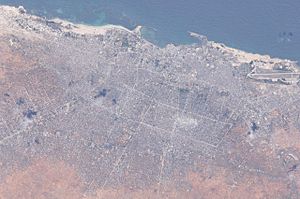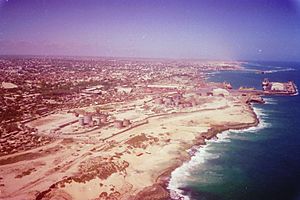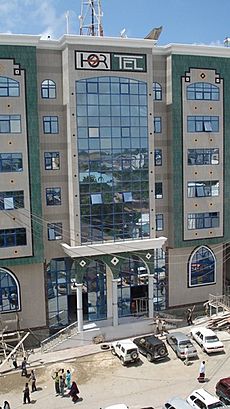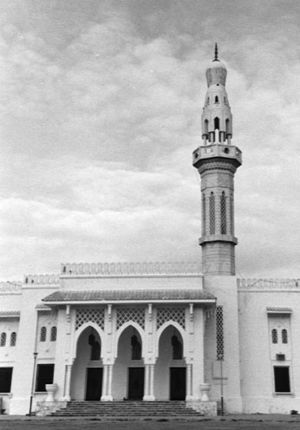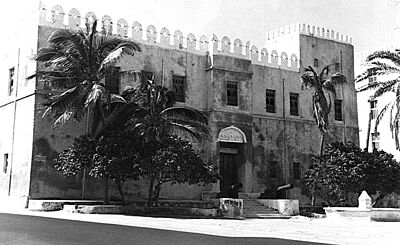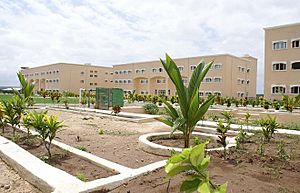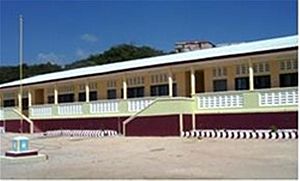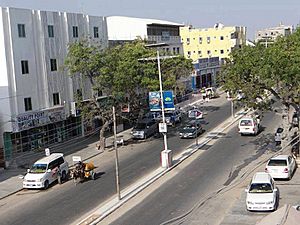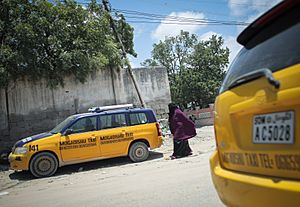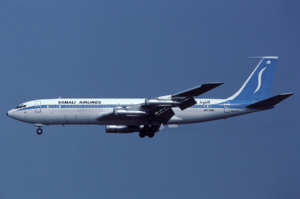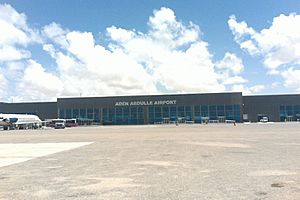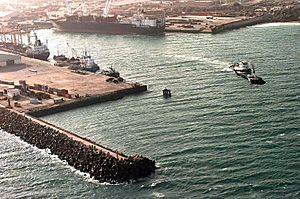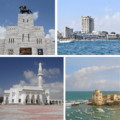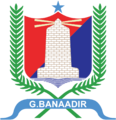Mogadishu facts for kids
Quick facts for kids
Muqdisho (Somali)
|
|||
|---|---|---|---|

Clockwise from top: Mohammed Abdullah Hassan monument, Lido Beach, the Old Fishing Harbour, and Mosque of Islamic Solidarity.
|
|||
|
|||
|
OpenStreetMap
|
|||
| Country | |||
| Region | Banaadir | ||
| Founded | 720AD | ||
| Area | |||
| • Urban | 127 km2 (49 sq mi) | ||
| Population
(2024)
|
|||
| • Urban | 2,726,815 | ||
| • Urban density | 21,470/km2 (55,600/sq mi) | ||
| Demonym(s) | Maqdishawi or Hamarawi | ||
| Time zone | UTC+03:00 (East Africa Time) | ||
| • Summer (DST) | (Not Observed) | ||
| Climate | BSh | ||
| HDI (2019) | 0.701 average 1st |
||
Mogadishu, also called Xamar or Hamar, is the capital and largest city of Somalia. It has been an important port city for thousands of years, connecting traders across the Indian Ocean. Today, about 2.7 million people live in Mogadishu.
The city is located on the coast of the Indian Ocean in the Banaadir region. This region is special because it's considered a city-state, not a regular federal state like other parts of Somalia.
Mogadishu has a very long and interesting history. It was once the capital of the Sultanate of Mogadishu from the 9th to 13th centuries. This sultanate controlled the gold trade in the Indian Ocean. Later, it became part of the Ajuran Sultanate in the 13th century, which was important for trade along the Silk Road. Mogadishu was very rich in the 14th and 15th centuries. It was known as the wealthiest city on the East African coast and a center for making cloth.
In the 17th century, the Hiraab Imamate took control of Mogadishu. Then, in the 19th century, the Sultanate of the Geledi became powerful in the area. European colonial rule began in the late 1800s, with Italy taking control. After World War II, the city was managed by the United Nations and Italy until Somalia became independent in 1960.
After independence, Mogadishu became the capital of the new Somali Republic. However, the city faced a long and difficult Somali Civil War starting in the early 1990s. In recent years, from the late 2010s, Mogadishu has been undergoing a big rebuilding effort.
Contents
- What Does the Name Mogadishu Mean?
- Mogadishu's Long History
- Mogadishu's Location and Layout
- Mogadishu's Economy
- Mogadishu's People
- Famous Places in Mogadishu
- Education in Mogadishu
- Culture and Sport
- Getting Around Mogadishu
- Media in Mogadishu
- Famous People from Mogadishu
- Sister Cities
- Images for kids
- See also
What Does the Name Mogadishu Mean?
The name Mogadishu (Muqdisho) has a few possible meanings. One idea is that it comes from Somali words Muuq and Disho, which mean "Sight Killer" or "Blinder." This might refer to the city's amazing beauty. Another idea is that it comes from the Persian phrase Magh'ad-e shāh, meaning "seat of the Shah" or "merchant Shah." This shows the city's early connection to Persian traders.
Mogadishu's Long History
Ancient Times: Sarapion
People believe that the ancient city of Sarapion was the first version of Mogadishu. It's mentioned in an old Greek travel guide from the first century AD called the Periplus of the Erythraean Sea. This book says Sarapion was one of many trading ports on the Somali coast. Back then, people in the Mogadishu area traded by sea with other communities around the Indian Ocean.
In ancient times, Mogadishu was part of the Somali city-states. These states had a busy trade network with places like ancient Egypt, Greece, and the Roman Empire. Somali sailors used special boats called beden to carry their goods.
How Mogadishu Started
For a long time, people wondered who first founded Mogadishu. Some thought it was Arab or Persian families. However, modern experts now believe that there were already Somali communities living on the coast. These local Somalis were in charge, and Arab and Persian traders had to ask for permission to settle. The local Somalis kept their power, and the new Muslim settlers often adopted the local language and culture.
Archaeological findings show that trade networks existed on the Somali coast about 4,000 years ago, even before many Arab traders arrived. This supports the idea that Mogadishu grew from existing local communities. When the famous traveler Ibn Battuta visited in the 14th century, he noted that the Sultan was of "Barbara" origin, an old term for the ancestors of the Somali people.
A Muslim geographer named Yaqut al-Hamawi wrote in 1220 that Mogadishu was the most important town on the coast. He said it was home to "Berbers," who were dark-skinned and are seen as ancestors of modern Somalis. By the 13th century, Mogadishu and other nearby cities had become important Islamic and trading centers in the Indian Ocean.
Mogadishu is traditionally home to four main clans: Moorshe, Iskashato, DhabarWeyne, and Bandawow. The Moorshe are thought to be the oldest group and are linked to the Ajuran Sultanate, a powerful kingdom in medieval Africa.
Mogadishu in the Middle Ages
The Mogadishu Sultanate
The Mogadishu Sultanate was a Somali kingdom in southern Somalia during the Middle Ages. It became a very strong power in the Horn of Africa under Fakhr ad-Din. Later, in the 13th century, it joined the growing Ajuran Sultanate. The Mogadishu Sultanate had a huge trading network, controlled the gold trade, made its own money, and built many impressive buildings in southern Somalia.
For many years, Mogadishu was the most important city in what medieval Arabic speakers called the "Land of the Berbers" (the Somali coast). A Syrian historian named Yaqut al-Hamawi visited in the 12th century and called Mogadishu the richest and most powerful city in the region. He also said it was an important Islamic center across the Indian Ocean.
Life in Medieval Mogadishu
When the Moroccan traveler Ibn Battuta visited Mogadishu in 1331, the city was at its peak. He described it as "an exceedingly large city" with many rich merchants. Mogadishu was famous for its high-quality cloth, which it sold to places like Egypt. Battuta also noted how welcoming the people of Mogadishu were to travelers. He said the city was ruled by a Somali Sultan named Abu Bakr ibn Shaikh 'Umar, who spoke Somali and Arabic. The Sultan had many important officials helping him.
Ibn Khaldun, another famous historian, wrote that Mogadishu was a huge city with many wealthy merchants.
Important people from this time include Abd al-Aziz of Mogadishu, who was a governor in the Maldives. A mosque in Mogadishu is named after him.
The island of "Madagascar" got its name because the explorer Marco Polo mistakenly thought it was Mogadishu in the 13th century.
In the 15th century, Vasco Da Gama saw Mogadishu and described it as a large city with tall houses, big palaces, and many mosques. In the 16th century, Duarte Barbosa noted that ships from India and Aden came to Mogadishu to trade cloth and spices for gold, wax, and ivory. He also said the city had plenty of meat, wheat, barley, horses, and fruit. Mogadishu was a busy center for weaving cloth and a stop for traders from other East African cities.
In 1542, a Portuguese commander briefly attacked Mogadishu, which led the Sultan to sign a peace treaty with the Portuguese.
The explorer Leo Africanus wrote in the 16th century that the people of Mogadishu were tall with olive skin, though some were darker. They wore rich white silk and Islamic turbans. Their weapons included swords, daggers, spears, and bows. They also got firearms like muskets and cannons from the Ottoman Empire. Mogadishu was a rich city-state with stone walls, trading with kingdoms worldwide.
The Ajuran Sultanate fell apart in the 17th century because of high taxes, leading to a rebellion. New Somali groups, like the Abgaal, moved into Mogadishu and took control of trade.
Early Modern Period (1700s–1900s)
The Hiraab Imamate
By the 17th century, the Hiraab Imamate was a strong kingdom ruling much of southern and central Somalia. It successfully broke away from the Ajuran Sultanate and ruled independently for about two centuries.
However, by the late 19th century, the Imamate started to weaken due to internal problems and challenges from other kingdoms.
The Geledi Sultanate
The Sultanate of Geledi and the Omani Empire both wanted to be the main power on the Benadir Coast. Sultan Yusuf Mahamud of Geledi became the stronger force. The Omanis had little real power, and their leader even paid tribute to Sultan Yusuf to keep his representatives in Mogadishu.
Mogadishu had been in decline under Abgaal control. Sultan Yusuf marched into the city with an army and helped settle a dispute between two powerful leaders, showing his control over Mogadishu.
Trade with the Geledi Sultanate grew during Sultan Ahmed Yusuf's rule. A British explorer, John Kirk, visited in 1873 and saw many large boats in Mogadishu and Merka filled with grain from Geledi farms. The Geledi Sultans were very powerful, controlling the ivory trade and the fertile valleys nearby. Omani officials in Mogadishu mainly collected taxes and needed forts for their own safety, not to control the city. The Fort of Garessa was built in 1870. Later, the Sultan of Zanzibar leased and sold the fort to the Italians, but not the land, which still belonged to Somalis.
Italian Somaliland (Late 1800s–1960)
In 1905, Italy made Mogadishu the capital of its new colony, Italian Somaliland. The Italians called the city Mogadiscio. After World War I, Italy gained more control over the surrounding areas, though there was some resistance.
Many Italians moved to Mogadishu and started businesses. They also developed farms in the south near the capital. In the 1930s, new buildings and roads were constructed. A railway was built from Mogadishu to Jowhar, and an asphalt road was planned to connect Mogadishu to Addis Ababa.
By 1940, about 22,000 Italians lived in Mogadishu, making up over 44% of the city's population. During World War II, British forces captured Mogadishu in 1941.
After the war, Mogadishu became the capital of the Trust Territory of Somaliland, which was managed by Italy under the United Nations for ten years (1950–1960).
Somali Republic (1960–1991)
British Somaliland became independent on June 26, 1960, and the former Italian Somaliland became independent five days later. On July 1, 1960, the two regions joined to form the Somali Republic, with Mogadishu as its capital. A new government was formed, and a new constitution was approved in 1961.
On October 15, 1969, Somalia's President Abdirashid Ali Shermarke was assassinated. This was followed by a military takeover on October 21, 1969, led by Major General Siad Barre.
Siad Barre's government renamed the country the Somali Democratic Republic. They arrested former government officials, banned political parties, and suspended the constitution.
The new government started big public projects, including the Mogadishu Stadium. They also took control of industries and land. In foreign policy, they focused on Somalia's ties with the Arab world and joined the Arab League in 1974.
After a war in the late 1970s, Barre's government began arresting people suspected of trying to overthrow him. Many were executed. Some officials escaped and formed groups to fight against Barre's rule.
Civil War and Recovery
By the late 1980s, Barre's government became very unpopular. Resistance groups grew across the country. Mogadishu saw its first major violence in July 1989, when about 400 civilians were killed in a crackdown. This led to many foreigners leaving the city and more opposition to the government. The Somali Civil War began in 1991, leading to the fall of Barre's government and the breakup of the army. Different armed groups then fought for control of the capital.
During the United Nations Operation in Somalia II, there were battles in Mogadishu between Somali groups and UN peacekeepers. The UN soldiers left the country in March 1995.
In 2006, the Islamic Courts Union (ICU) took control of much of southern Somalia and brought in Islamic law. The new Transitional Federal Government (TFG) tried to take control. With help from Ethiopian troops, African Union peacekeepers, and the United States, the TFG pushed out the ICU. In January 2007, the TFG President entered Mogadishu, marking the first time since 1991 that the federal government controlled most of the city.
After this defeat, the Islamic Courts Union split. Some radical groups, like al-Shabaab, continued fighting against the TFG and the Ethiopian military. Al-Shabaab gained control of many towns in 2007 and 2008. By January 2009, al-Shabaab forced Ethiopian troops to leave, leaving behind a small African Union peacekeeping force.
In 2008, Somalia's government and a moderate rebel group held peace talks in Djibouti. They agreed that Ethiopian troops would leave if the fighting stopped. The government then expanded to include members of the rebel group. With the help of African Union troops, the government began to take back control of southern Somalia.
In November 2010, a new government was elected and made many improvements, especially in security. By August 2011, the government and its allies had taken all of Mogadishu from al-Shabaab. Since then, Mogadishu has been rebuilt by Somalis living abroad, local authorities, and Turkey.
Rebuilding Mogadishu
When al-Shabaab left Mogadishu in August 2011, the city's mayor saw a chance to rebuild. His team worked with the UN and other groups to fix roads and buildings. Residents also helped improve security. The city government started a project to name streets, number houses, and create postal codes. This helps with security and solving property disputes. By 2016, there were postal codes for many areas in Mogadishu.
Mogadishu's Location and Layout
Mogadishu is on the coast of the Indian Ocean in Northeast Africa. It's in the Banaadir region, which is the same size as the city itself. The city is divided into eighteen districts. Some famous places include the Hamarwein old town, the Bakaara Market, and Gezira Beach. Mogadishu's sandy beaches have colorful coral reefs and are becoming popular for tourist resorts.
The Shebelle River starts in central Ethiopia and flows within 30 kilometers (19 miles) of the Indian Ocean near Mogadishu. It then turns southwest. The river is usually dry in February and March, but it provides important water for growing crops like sugarcane, cotton, and bananas.
Mogadishu's Climate
Even though Mogadishu is close to the equator, it has a dry climate. It's classified as a hot and dry-winter semi-arid climate. Summer (June-August) is the coldest and rainiest time of year. The city is relatively dry, but because it's on the coast, the air is quite humid, averaging 79% humidity all year.
The average temperature in Mogadishu is 27°C (81°F) year-round. The city gets about 429 millimeters (17 inches) of rain per year, with about 47 rainy days. Mogadishu enjoys a lot of sunshine, with an average of 8.4 hours of sunlight per day.
Mogadishu's Economy
Mogadishu has always been a center for business and money. Before mass-produced cloth came from Europe, the city's textiles were sold all over Africa, the Arabian Peninsula, and even to the Persian Gulf.
Mogadishu's economy has grown quickly since the city became safer in mid-2011. Factories like SomalFruit and Coca-Cola have reopened. In May 2012, the First Somali Bank opened, which was the first commercial bank in southern Somalia since 1991. The city also got its first "dollar store."
Rebuilding in Mogadishu has been helped by a construction yard set up in November 2012 by the city of Istanbul and the Turkish Red Crescent. This yard produces concrete, asphalt, and paving stones for building projects.
In 2012, Mogadishu hosted its first TEDx conference. This event was organized to show how business, development, and security were improving to attract investors. A second conference was held the next year, highlighting new businesses like the city's first dry cleaning service in years.
Many large companies have their main offices in Mogadishu. These include the Trans-National Industrial Electricity and Gas Company, a big energy company. Hormuud Telecom is the largest telecommunications company in southern and central Somalia. The Central Bank of Somalia, which manages the country's money, is also in Mogadishu.
In June 2013, a new law was signed to encourage foreign investment. This law creates a safe legal system for foreign businesses to invest in Mogadishu and other parts of Somalia.
In October 2014, a company called Tawakal Money Express started building the seven-story Tawakal Plaza Mogadishu. This new building will have a bank, a large supermarket, a luxury hotel, restaurants, and conference halls. Another company, Al Buruuj, started a big real estate project in January 2015 called Daru-Salam City. This new urban area will include homes, a mosque, play areas, and a supermarket.
Mogadishu's People
| Historical population | ||
|---|---|---|
| Year | Pop. | ±% |
| 1936 | 50,000 | — |
| 1941 | 72,000 | +44.0% |
| 1944 | 72,000 | +0.0% |
| 1947 | 73,000 | +1.4% |
| 1950 | 55,000 | −24.7% |
| 1953 | 63,000 | +14.5% |
| 1956 | 75,000 | +19.0% |
| 1959 | 104,332 | +39.1% |
| 1962 | 116,222 | +11.4% |
| 1965 | 171,312 | +47.4% |
| 1968 | 172,700 | +0.8% |
| 1972 | 230,000 | +33.2% |
| 1982 | 500,000 | +117.4% |
| 1984 | 570,000 | +14.0% |
| 1991 | 1,100,000 | +93.0% |
| 2017 | 2,425,000 | +120.5% |
| Sources: Italian Somaliland, British Military Administration, United Nations and Mogadishu municipal estimates and censuses; Population size may be affected by changes on administrative divisions. | ||
Mogadishu is home to all Somali clan-families, with the Abgaal and Murusade clans being the most common. Besides Somalis, other groups have lived in the city throughout history. Arab and Persian migrants settled there during the medieval period. Over centuries, different ethnic groups, including Bantus, mixed through marriage, creating a minority group called Benadiris. During the colonial period, Europeans, mainly Italians, also added to the city's diverse population.
After security improved in 2012, many Somalis living abroad began returning to Mogadishu. They came back to invest and help rebuild the city. They have helped fix schools, hospitals, banks, and other buildings. They have also boosted the local housing market. Since 2015, Mogadishu has seen more refugees and migrants, especially from Yemen and Syria, who are fleeing conflict.
In 2017, Mogadishu had about 2,425,000 residents. It is one of the largest cities in the world by population.
Famous Places in Mogadishu
Places of Worship
Most places of worship in Mogadishu are Muslim mosques.
The Arba'a Rukun Mosque is one of the oldest mosques in the capital. It was built around 1268–1269 AD, at the same time as the Fakr ad-Din Mosque.
The Mosque of Islamic Solidarity was built in 1987 with money from Saudi Arabia. It is the main mosque in the city and an important symbol in Somali society. It can hold up to 10,000 worshippers, making it the largest mosque in the Horn of Africa. In 2015, the government finished renovating the mosque.
The Mogadishu Cathedral was built in 1928 by the Italian colonial government. It was designed in a Norman Gothic style, similar to a cathedral in Sicily. It served as the main church for the Roman Catholic Diocese of Mogadiscio. The church was badly damaged during the civil war. In 2013, there were plans to rebuild it.
Palaces
Villa Somalia is the official home and workplace of the President of Somalia. It is located on a hill overlooking the city and the Indian Ocean, with easy access to the harbor and airport.
The Governor's Palace of Mogadishu was once the home of the Italian governor and later the administrator of the Trust Territory of Somalia.
Museums, Libraries, and Theatres
The National Museum of Somalia was created after independence in 1960. It holds many important cultural items, including old coins, traditional artwork, ancient weapons, and pottery.
The National Library of Somalia was started in 1975. It had about 7,000 books in 1983 and was open to the public. The library closed in the 1990s during the civil war. In 2013, a project began to restock the library with 22,000 books from the United States. In December of that year, the Somali government officially started a big project to rebuild the National Library. A new library complex is being built, and 60,000 more books are expected from other Arab countries.
The National Theatre of Somalia opened in 1967 as an important cultural place. It closed during the civil war but reopened in March 2012 after being rebuilt. In 2013, the Somali government and China signed an agreement for China to help rebuild the National Theatre and other important buildings.
Markets
Bakaara Market was created in 1972. It was an open market where people sold goods and services, including food and clothes. After the civil war began, militant groups controlled the market. After Mogadishu became safer in 2011, the market was renovated. Shops were repaired, selling everything from fruit to building materials. Property values in Bakaara Market have also increased a lot.
In February 2014, the city government began renovating the Ansaloti Market. It was one of the largest markets before closing in the 1990s. In September 2014, the market reopened to the public.
Institutes
The Regional Somali Language Academy is a group that works to regulate the Somali language in the Horn of Africa. In 2015, the President of Somalia announced that the institute would be finalized with the help of Djibouti and Ethiopia. A new headquarters for the academy is being built in Mogadishu.
Hotels
Mogadishu has many hotels, most of which are new. Many Somalis returning from abroad, investors, and foreign workers are the main customers. To meet the growing demand, hotel owners are attending international conferences.
One new hotel is the six-floor Jazeera Palace Hotel, built in 2010 and opened in 2012. It's close to the Aden Adde International Airport and has 70 rooms. Other hotels in the city include the Lafweyn Palace Hotel, Amira Castle Hotel, and Sahafi Hotel.
Education in Mogadishu
Mogadishu has many schools and universities. As part of the government's rebuilding plan, 100 schools across the country are being renovated and reopened. Education is compulsory for 15 years, and primary and middle school are free in public schools for children aged 7 to 19. By 2015, almost 55% of children in this age range were enrolled in school. High school is not mandatory but is needed to go to university.
The Somali National University (SNU) was founded in the 1950s. It grew into a large university with 13 departments and over 15,000 students. In November 2013, the government approved a plan to reopen the SNU, which had been closed since the early 1990s. The renovation cost $3.6 million and was finished in August 2014.
Mogadishu University (MU) is a private university started by professors from the Somali National University. It is funded by the Islamic Development Bank and other groups. The university has hundreds of graduates from its seven departments. Mogadishu University works with many other universities around the world.
In 1999, the Somali Institute of Management and Administration (SIMAD) was started in Mogadishu. It later became SIMAD University. It offers many courses, including economics, computer science, and law.
Benadir University (BU) was founded in 2002 to train doctors and has since expanded to other fields. Other universities in the city include Zamzam University of Science and Technology and Jamhuriya University of Science and Technology. New schools and university campuses are also being built or renovated.
Culture and Sport
General Culture
As Somalia's capital, Mogadishu is home to many important national organizations. It is where the Federal Government of Somalia is located, with the Federal Parliament of Somalia as its law-making body. The Mayor of Mogadishu manages the city. Villa Somalia is the official home and workplace of the President of Somalia.
Mogadishu is also a center for education and media. Many schools are being renovated and reopened. The Somali National University and Mogadishu University are important learning centers.
Sport
The Mogadishu Stadium was built in 1978 with help from Chinese engineers. It was mainly used for sports like football matches and the Somalia Cup. It also hosted presidential speeches and political events. In 2013, the Somali government and China agreed to rebuild the Mogadishu Stadium.
The Banadir Stadium and Konis Stadium are two other major sports facilities in the capital. In 2013, the Somali Football Federation started a renovation project at Konis Stadium, installing artificial football turf. Other sports facilities are also being rebuilt.
National sports organizations have their headquarters in Mogadishu. These include the Somali Football Federation, the Somali Olympic Committee, and the Somali Basketball Federation.
Getting Around Mogadishu
Roads
Roads from Mogadishu connect the city to other places in Somalia and neighboring countries. The city itself has a large network of roads. In October 2013, major construction began on the 23-kilometer (14-mile) road to the airport. This was part of an agreement between Somalia and Turkey to make Mogadishu and Istanbul sister cities and upgrade all of Mogadishu's roads.
In 2012–2013, the city government, with help from the British and Norwegian governments, started installing solar-powered street lights on all major roads. This has improved visibility at night and made the city look better.
Minibuses are the most common type of public transport in Mogadishu. Auto rickshaws (bajaj) are also very popular. There are about 3,000 of them, and they are cheaper than taxis and minibuses. They are good for short trips and can go through narrow streets. In June 2013, two new taxi companies started offering rides throughout the city for a flat rate of $5.
In January 2014, the city government started a project to name streets, number houses, and create postal codes. This helps with security and solving housing issues.
Air Travel
After Somalia gained independence, Mogadishu International Airport offered flights to many places around the world. In the mid-1960s, the airport was expanded to handle more international planes. The national airline, Somali Airlines, had regular flights to many major cities.
The airport grew a lot after independence. However, during the civil war in the early 1990s, flights were often disrupted, and the airport was damaged. In the late 2000s, the K50 Airport, 50 kilometers (31 miles) south, served as the main airport while Mogadishu International Airport (now Aden Adde International Airport) was closed. But by late 2010, security in Mogadishu had improved, and the government took full control of the city by August 2011.
In May 2011, a company was hired to manage operations at the reopened Aden Adde International Airport for ten years. This company invested in new equipment and trained 200 local workers to meet international standards. They also helped renovate the airport, restore electricity, improve baggage handling, and set up electronic check-in systems.
In December 2011, the Turkish government announced plans to further modernize the airport, including a new control tower. In September 2013, a Turkish company began operations at the airport. This $10 million project will increase the airport's capacity from 15 to 60 aircraft. In January 2015, a new, modern terminal opened, allowing the airport to handle 60 commercial flights a day and about 1,000 passengers per hour.
As of January 2015, the largest airlines using Aden Adde International Airport include Somali-owned carriers like Jubba Airways and Daallo Airlines, as well as Turkish Airlines. The airport offers flights to other cities in Somalia and international destinations like Djibouti, Jeddah, and Istanbul.
In July 2012, the Somali government announced plans to bring back the national airline, Somali Airlines.
Sea Travel
The Port of Mogadishu, also called the Mogadishu International Port, is the city's official seaport. It is the largest harbor in Somalia.
After being damaged during the civil war, the government started a project to rebuild and modernize the port. In 2013, the port management made an agreement with an Iranian company to handle important operations at the seaport.
In October 2013, the government approved a deal with a Turkish company to manage the Port of Mogadishu for 20 years. This company will also rebuild and modernize the port. The modernization project will cost $80 million.
Railway
In the 1980s, there were plans to restart the 114-kilometer (71-mile) railway between Mogadishu and Jowhar. This railway was built by the Italians in 1926 but was taken apart by British troops in World War II. It was originally meant to reach Addis Ababa. Today, only a few tracks inside Mogadishu's harbor area are still used.
Media in Mogadishu
Mogadishu has always been a center for media. In 1975, the Somali Film Agency (SFA) was created in Mogadishu. The SFA also organized an annual film festival that brought together filmmakers from around the world.
Many radio news stations are based in Mogadishu. Radio Mogadishu is the government-run public radio station. It was started in 1951 and first broadcast news in Somali and Italian. After independence in 1960, it was modernized and began offering services in Somali, Amharic, and Oromo. It closed during the civil war but reopened in the early 2000s. Other radio stations in the city include Mustaqbal Radio, Radio Shabelle, and Radio Kulmiye.
The Mogadishu-based Somali National Television (SNTV) is the central government-owned TV station. It was officially relaunched in April 2011 and broadcasts 24 hours a day, both within Somalia and abroad.
Somali popular music is very popular in Mogadishu. After the city became safer in 2011, radios once again played music. In March 2012, a concert was held in the city and broadcast live on TV. In April 2013, a music group organized the Reconciliation Music Festival, the first international music festival in Mogadishu in two decades. Mogadishu is also home to Bilan Media, a Somali newspaper made up only of women, started in 2020.
Famous People from Mogadishu
- Hassan Sheikh Mohamud, President of Somalia
- Sharif 'Aydarus Sharif Ali Al-Nudari, famous Islamic scholar
- Shaykh Sufi, 19th-century scholar and poet
- Hawa Abdi, doctor and social activist
- Yasmine Allas, actress and writer
- Ayub Daud, footballer
- Cristina Ali Farah, author
- Hassan Abshir Farah, former Prime Minister of Somalia and Mayor of Mogadishu
- Ali Mohammed Ghedi, former Prime Minister of Somalia
- Iman, model, actress, and entrepreneur
- K'naan, musician
- Rageh Omaar, journalist
- Diriye Osman, writer and visual artist
- Fatima Siad, model
- Ladan Osman, poet
- Sa'id of Mogadishu, 14th-century Islamic scholar and traveler
- Mohamed Abdullahi Mohamed, former Prime Minister and President of Somalia
- Mustafa Mohamed, long-distance runner
- Mohamed Nur, former Mayor of Mogadishu
- Musse Olol, engineer and social activist
- Omar Abdirashid Ali Sharmarke, former Prime Minister of Somalia
- Samia Yusuf Omar, athlete who died trying to reach the 2012 Olympics
- Yasmin Warsame, model
- Said Abdullahi Deni, President of Puntland State of Somalia
- Abdulqawi Ahmed Yusuf, former President of the International Court of Justice
Mogadishu-born citizens of other countries:
- Saba Anglana, Italian citizen. Singer and actress
- Zahra Bani, Italian citizen. Javelin thrower
- Elisa Kadigia Bove, Italian citizen. Actress and activist
- Linda Suleiman, orthopedic surgeon
- Mo Farah, English citizen. Distance runner
- Ayaan Hirsi Ali, Dutch citizen. Former politician and activist
- Ilhan Omar, American citizen. U.S. Representative
- Omar Abdirashid Ali Sharmarke, former Somali Prime Minister
Sister Cities
Mogadishu is connected with these cities:
 Ankara, Turkey
Ankara, Turkey Doha, Qatar
Doha, Qatar Konya, Turkey
Konya, Turkey Medina, Saudi Arabia
Medina, Saudi Arabia Saint Paul, Minnesota
Saint Paul, Minnesota Almaty, Kazakhstan
Almaty, Kazakhstan
Images for kids
See also
 In Spanish: Mogadiscio para niños
In Spanish: Mogadiscio para niños



